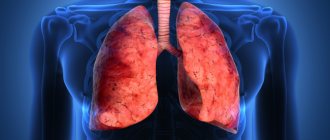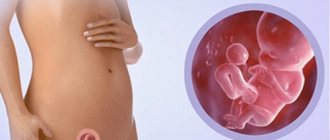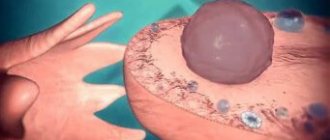Some anatomical and physiological features of the female body
The external female genitalia (pubis, labia, vestibular bulb, large and small vestibular glands, clitoris) are designed to protect the internal genital organs. The labia minora border the urethral opening and the vestibule of the vagina. The clitoris is the connection point of these organs. It is rich in nerve endings, so its main function is to bring pleasure to a woman. Inside, the vagina is connected to the cervix. Next, the uterus expands, a fertilized egg (zygote) enters it, from which the fetus is subsequently formed. If the egg is not fertilized, it leaves the body along with bloody discharge. Accordingly, the place prepared for implantation of the zygote also becomes unnecessary. 2 weeks after ovulation, the endometrial epithelium is torn off and excreted in the form of bloody discharge. After this, the cycle repeats again.
Diagnostic methods
If cycle irregularities are detected, you should contact a gynecologist. A woman may need to consult an endocrinologist, neurologist, therapist, or oncologist.
To identify the cause, a comprehensive examination will be prescribed, which includes a gynecological examination, smear collection, coagulogram, biochemical blood test, assessment of hormone levels (estradiol, progesterone, FSH, LH, prolactin, TSH, etc.), ultrasound of the pelvic organs.
In some cases, an MRI, hysteroscopy, or biopsy may be required.
First of all, the gynecologist will rule out the direct influence of external factors and concomitant diseases.
Timely diagnosis will help to identify existing problems in time, prescribe adequate therapy and normalize the cycle.
Cycle phases
How many days does the menstrual cycle (MC) last? This question interests many. The duration of this process under ideal conditions should be 28 days. Theoretically, the female body is ready for pregnancy every month. Girls whose MC is more than 28 days but less than 36 days should not worry, since all these are normal variants. A long cycle between periods is most likely an indicator of a long first half of the cycle, that is, the follicular phase. Under such conditions, the oocyte simply needs more time to mature. Any changes in the rhythms of the cycles should be a reason to consult a doctor.
Phases of the menstrual cycle:
- Stage I (menstrual). One of the most painful, since at this time menstrual flow and epithelial rejection are observed. The first days are the most painful period in the cycle. On average, the first phase of the menstrual cycle ranges from 3-6 days. The first day of menstruation is considered to be the beginning of MC.
- Stage II (follicular). The content of pituitary hormones in the blood increases. The main one is FSH (follicle-stimulating hormone), it stimulates the ovaries to produce eggs (female reproductive cells). Follicles are sacs in the ovaries that are filled with fluid. Each follicle contains an immature egg. FSH activates the maturation of a certain number of follicles. The ovaries produce female steroid hormones (estrogens), which prepare the endometrium for implantation of a fertilized cell. The second phase of the cycle lasts 14 days.
- Stage III (ovulatory). The duration of the phase is about three days. The mature egg leaves the follicle and then moves through the fallopian tubes to the uterus. By the time of puberty, girls have up to half a million eggs in their ovaries. Their laying occurs during the embryonic period. The process of an egg leaving the follicle is called ovulation. How many eggs mature in one cycle? About 20 gametes normally mature in the ovary every month. When a follicle ruptures, one, or less often 2-3, eggs emerge from its cavity. Very often, ovulation in girls is accompanied by severe pain. Most often it hurts in the lower abdomen.
- Stage IV (luteal). The duration of the phase varies in the range of 10-16 days. At this time, many hormones (progesterone and estrogen) are synthesized, preparing the entire body for bearing a child.
First phase
The appearance of bleeding coincides with the beginning of the first phase of the menstrual cycle - follicular. The uterus rejects the inner layer (endometrium), which has grown over the previous month. At the same time, the process of follicle maturation begins in the ovary under the influence of follicle-stimulating hormone (FSH).
During the period that menstruation lasts, from 7 to 12 cells begin to grow. The largest follicle (dominant) continues to develop 7 days after the start of the cycle, the rest atrophy.
Do you keep track of the phases of your cycle?
Yes, sometimes No
The lining of the reproductive organ comes out of the woman’s body in small fragments, mixed with blood from damaged vessels. Its share in the total volume of emissions is relatively small - no more than a third. Therefore, after menstruation, healthy women remain in normal health and do not develop anemia.
See also: Can there be a delay after the first time?
In the first days of a new cycle, a girl may experience heaviness and pain in the lower abdomen. This is due to the fact that the muscular layer of the uterus contracts spasmodically to expel dead endometrium.
Menstruation lasts 3-5, sometimes 7 days. If bleeding does not stop longer, this is a reason to suspect disturbances in the functioning of the reproductive system.
If the follicles do not grow or do not reach the required size during the follicular phase of the cycle, ovulation does not occur. A woman with this disorder cannot become pregnant. Another failure is the presence of many small secondary follicles on days 8-9 of the cycle . This disorder may be associated with ovarian stimulation and the use of contraceptive medications.
Normal cycle
How long is the normal menstrual cycle? There is no clear answer to this question. For each lady this figure is strictly individual. Doctors identify a number of signs that characterize normal MC:
- Cycle stability. Deviations of 2-3 days are considered normal. Some representatives of the fair sex have a cycle shorter than 21 days, while others have a longer cycle than 35 days. Scientists explain this by the morphofunctional characteristics of the body, so if the duration of the cycle remains unchanged for a long time, this is not considered a disorder.
- During the menstrual period, the volume of blood lost should be no more than 80 ml. It is worth noting that menstrual blood does not clot, as it contains an anticoagulant - the enzyme plasmin.
- Normally, the duration of bleeding should be from 3 to 7 days.
- Menstruation should not be too painful.
What determines the length of the menstrual cycle?
When talking about how long the normal period of the monthly cycle lasts, you need to take into account the characteristics of the female body. For some representatives of the fair sex, the normal interval between desquamations may be 21 days, for others – 35.
Cycling may be irregular. Most often this is due to changes in hormonal levels. To stabilize it, gynecologists prescribe medication.
If a change in hormonal levels, in addition to menstrual disruption, leads to symptoms such as nausea, menorrhagia (heavy menstruation), severe pain in the uterine area, it is possible that a pathological process is developing in the body.
In addition to hormonal imbalance, there are other factors that influence the duration of the menstrual cycle:
- Diseases of the endocrine system (for example, damage to the adrenal glands).
- Inflammation of the pelvic organs.
- Sudden weight loss or weight gain.
- Gynecological pathologies (for example, uterine fibroids or polyposis).
- Sudden change in weather or climate.
- Psycho-emotional stress.
If the ovulatory or luteal phase comes late, you should not hesitate to visit a gynecologist. Lack of timely treatment of the pathology is fraught with dangerous complications, including infertility.
Permissible deviations
How long the menstrual cycle lasts in healthy women, as well as the volume of discharge, largely depends on various life circumstances (diet, exposure to stress factors, taking contraceptives, giving birth, etc.). There are many reasons for a missed period, but is a long-term physiological delay possible?
Deviations from normal periods are most often observed in young girls and women before menopause. It is believed that a delay in menstruation of up to six months may be normal. Sometimes changes, a change in the menstrual cycle, are observed in girls after their first sexual experience. Experts explain this fact as a strong emotional shock. However, normally the discrepancies should not exceed several days from the established cycle.
During the postpartum period, women may also experience disruptions in the menstrual cycle. Under ideal conditions, pregnancy should not be accompanied by menstruation. If a young mother does not breastfeed her baby, then the menstrual cycle is quickly restored and returns to normal in the shortest possible time. This is due to the low concentration of prolactin in the blood of women.
Reasons for deviations from the norm
An excessively long or short cycle, early and late ovulation, scanty or heavy discharge, pronounced manifestations of PMS - all these factors may indicate disruptions in the body, which is reflected in the length of the cycle.
Why does the loop fail:
- natural aging of the body - the closer to menopause, the less regular the cycle becomes;
- stress, nervous and physical fatigue;
- a sharp increase or decrease in weight by more than 10%;
- taking oral contraceptives;
- puberty;
- climate change;
- postpartum period, lactation;
- recent abortion;
- gynecological diseases of an inflammatory nature;
- venereal diseases;
- disturbances in the functioning of the pituitary gland and adrenal glands.
Important! You should consult a doctor immediately if you have not had your period for more than 2 months, if this is not related to pregnancy, if the cycle lasts less than 21 days, if spotting lasts less than 3 or more than 7 days, appears in the middle of the cycle, or a year after the onset of menopause .
In diseases of the adrenal glands, cycle disruption occurs.
When to see a doctor
Doctors recommend that all girls and women keep a calendar for monitoring menstruation. The calendar of women's monthly cycles helps determine their regularity and duration, as well as the duration of menstruation. This information will be useful not only to the patient, but also to the treating doctor.
Common causes of irregular periods:
- stressful situations;
- physical or mental fatigue;
- starvation;
- systematic lack of sleep;
- diets;
- avitaminosis;
- hormonal imbalance;
- autoimmune abnormalities;
- diseases of the genitourinary system (endometriosis, oophoritis, uterine fibroids, cystitis, polycystic ovaries, adnexitis);
- alcohol or nicotine intoxication;
- prolonged depression;
- pathology of the endocrine system;
- taking certain medications;
- acclimatization;
- exhaustion;
- presence of chronic diseases;
- psychological shocks;
- obesity;
- presence of neoplasms;
- unfavorable environment.
The above factors negatively affect the functioning of all organs and systems of the body. In this case, the reproductive system is no exception. In this regard, a normal menstrual cycle (MC) should last between 21 and 36 days. Menstruation that follows the specified interval is called regular, normal, ideal or regular.
Every lady must know what happens in the female body during menstruation and when to seek help from a specialist:
- The mammary glands hurt and swell.
- Irregular periods.
- Paleness, dizziness.
- The duration of menstruation is more than a week.
- Vaginal itching.
- Rare or, conversely, frequent menstruation.
- General weakness.
- Menstruation outside the cycle.
- Severe pain in the abdomen (such menstrual pain most often worries girls and nulliparous women) or in the area of the external genitalia.
- Menstruation is accompanied by severe pain and general weakness of the body;
- Menstruation is accompanied by heavy discharge.
- The overall body temperature increases.
Menstrual cycle disorders
The total duration of the cycle is normally 21-35 days. A deviation of one or two days is not considered a pathology.
Shortening or lengthening of the luteal phase indicates certain pathological abnormalities in the woman’s reproductive system.
The most common cycle disorders include:
- 1 Oligomenorrhea - too short menstruation, the duration of which does not exceed 1-2 days.
- 2 Opsomenorea - an increase in the interval between two menstrual bleedings to 5-8 weeks.
- 3 Amenorrhea is an interval between periods that is too long (more than 6 months) or their complete absence.
- 4 Hypomenorrhea – extremely scanty menstruation.
- 5 Abnormal uterine bleeding.
- 6 Dysmenorrhea (algodysmenorrhea) - painful menstruation.
The reasons for deviations from the norm may be associated with disruptions in the endocrine system, genetic predisposition, structural features of the uterus, sudden weight loss, and intense physical activity.
The periodicity of menstruation can be disrupted by taking oral contraceptives, pathologies of the thyroid gland, liver, adrenal glands, hemostasis disorder, infections, and stress.
A one-time cycle failure is not a cause for concern, but if there are frequent failures, you should consult a doctor.
It is worth remembering that the cycle lengthens in women over 45 years of age due to the gradual decline of ovarian function and the onset of menopause.
A long delay in the onset of menstruation may be a sign of pregnancy.
Failures can occur during puberty in teenage girls, when climate conditions change, during the postpartum period, and also during breastfeeding.
What are the reasons for a long gap between menstruation?
The maximum menstrual cycle, considered normal, is 32 days. If the duration is from 32 to 35 days, they speak of a borderline state, which may be a variant of the norm. A cycle longer than this indicates hormonal imbalances.
From this video you will learn about the normal duration of menstruation in women:
Causes of a long menstrual cycle:
- Persistence of the follicle - it does not burst, ovulation does not occur, the onset of the second phase of the cycle is delayed.
- Follicular atresia - an immature follicle is not able to burst, the cycle becomes single-phase.
- Persistence of the corpus luteum and excessive production of progesterone (extension of the second phase with a normal first).
Normally, the menstrual cycle lengthens after childbirth and before menopause.
Reasons for shifting the phases of the menstrual cycle
Sometimes women experience a shift in the phases of the menstrual cycle and there must be good reasons for this, because the onset of menstruation is a mandatory process for a healthy woman of childbearing age.
- The absence of bleeding or an excessive amount of it in the first phase (more than 7 days) may indicate pathologies in the genitals or a malfunction in the production of hormones that are responsible for the onset of one or another phase of the cycle. The lady should worry about her health and consult a doctor for advice and examination.
- The absence of menstruation may indicate an ovarian pathology, such as an inflammatory process or polycystic disease, when the follicles are not able to develop and form a healthy egg. Then there is nothing to come out, even in the absence of pregnancy. Conception in such a situation is impossible.
- In the practice of gynecologists, other reasons for the shift in the phases of the female cycle are also relevant, when menstruation occurs 2 times a month or bleeding is very scanty, but frequent. The question arises about neoplasms in the uterine cavity, ovaries, endometriosis is assumed - an inflammatory process in the epithelium of the uterus, when the endometrium exfoliates and wanders chaotically throughout the body or comes out in the form of menstruation.
- Taking medications that inhibit the functioning of a woman’s genital organs or the production of a certain hormone. Then the phases of the cycle may also shift, which will lead to unpleasant results - unwanted pregnancy or infertility.
- Nervous stress, psychological trauma, non-compliance with diet, rest and work can also lead to a shift in the phases of the menstrual cycle. Women may talk about the absence of menstruation, an increase or decrease in fluid volume.
- Nicotine, alcohol, and drugs also do not promise health to the female body and primarily affect the reproductive organs, causing their atrophy or partial suppression of menstruation when the cycle is unstable.
A woman should know the phases of her cycle and its duration in order to contact a gynecologist at the slightest failure in this process to identify pathologies that can be serious and require immediate treatment, in some cases surgical.
What happens during the second phase
It is generally accepted that the luteal phase is the second. Ovulation lasts only a couple of hours or a day and is the so-called connecting link.
In the second phase, the formation of the corpus luteum occurs
The second phase of the cycle lasts up to 2 weeks, depending on individual characteristics. Characterized by the formation of the corpus luteum. All changes are activated thanks to the luteinizing hormone, which is produced by the pituitary gland.
The main responsibility of the corpus luteum is the production of progesterone. In this way, the body prepares for possible conception.
Progesterone produced in the second phase has the following effects:
- increases the sensitivity of the endometrium;
- relaxes the muscle layer of the uterus;
- activates uterine enlargement;
- supports the body's protective functions;
- promotes the deposition of subcutaneous fat;
- stops critical days upon successful fertilization.
If fertilization is successful, the corpus luteum is destroyed and hormones are produced by the placenta. If there is no pregnancy, then menstruation begins.
After conception, the corpus luteum is destroyed
“Life” of menstruation in general
Menarche is the name given to the first menstruation. Most often, they come to teenagers aged 11-16 years. But, due to the individual characteristics of the body, there may be slight deviations in one direction or another.
In general, it is believed that by the age of 17 the menstrual cycle should be fully restored. If this does not happen, the direct route is to a teenage gynecologist.
Previously, it was noticed that the first periods come to girls 2-2.5 years after the start of mammary gland growth. This doesn't mean that it has to be this way for all teenagers.
The onset of menstruation can be influenced by various factors:
- Genetics. For example, if a girl’s relatives on the female side had their first early menstrual flow, there is a high probability of the situation repeating in the younger generation. This point also includes other genetic features: late menstruation, prolonged or heavy discharge, etc.
- How much time does a teenager devote to physical development and special nutrition for this.
- Place of residence, including localization of residence (village, city).
- How many diseases were suffered in childhood?
- And others.
At first, your menstrual cycle will be irregular. This is due to the imperfect girl’s body; it needs time to stabilize. After 2 years everything should get better.
Then the monthly norm begins, which consists of stability, systematicity of menstrual cycles until the period of menopause.
The climacteric period occurs on average at 45-55 years. It is characterized by decreased ovarian function. Simply put, when a woman’s period ends forever, she will no longer be able to get pregnant.
Ovulatory phase
With a twenty-eight-day menstrual cycle, the ovulatory phase lasts from 36 to 48 hours, it begins on the fourteenth to fifteenth day. During the ovulatory phase, the level of estrogen reaches its peak, which stimulates the production of luteinizing hormone in the pituitary gland, under the influence of which the dominant follicle ruptures.
After this, a mature egg is released into the abdominal cavity. Then the level of estrogen begins to gradually decrease. During the ovulatory phase, you may experience some light (usually one or two drops of blood on your underwear) ovulatory bleeding.
The ovulatory phase is the most favorable period for conception (the egg is viable for twenty-four hours).
During the twelfth to fifteenth days of the menstrual cycle, a woman unconsciously carefully monitors her appearance, she becomes more passionate (due to increased sexual desire), and also more feminine. She feels great.
Follicular phase
Phase 1 lasts on average two weeks. The first 3-7 days of the follicular phase are accompanied by the release of bloody secretion. On the seventh day of the cycle, menstruation stops, after which the endometrium is actively renewed. Simultaneously with the proliferation stage, the follicle and egg cell mature. During this period, estrogens and follicle-stimulating hormones are actively produced.
After a week, one follicle overtakes the others, which is why they stop growing and developing. The leader vesicle grows the egg cell until it reaches 20-25 millimeters. After the end of the follicular phase of the cycle, the entire reproductive system prepares for possible fertilization. At the end of the proliferative phase, ovulation occurs.
At the same time, the level of estrogen increases significantly, which serves as a signal for the production of another hormone - luteinizing hormone. It is what prepares the body for ovulation. A high concentration of estrogen helps the endometrium to be saturated with useful substances and blood, so that during pregnancy the uterus can normally contain the egg, promoting its growth and development. At this point, the first phase of the cycle ends and the second menstrual phase begins. It is the shortest, as it lasts only 24-35 hours.
Having understood what the follicular phase is and which days of the cycle it affects, we can begin to consider the ovulatory phase.
What is the menstrual cycle: when does it start and how long does it last?
The menstrual cycle is one of the main functions of the reproductive system of the female body. It depends on many factors. From about 11-13 years old, hormonal changes occur in the body of every girl. This entails changes in the functioning of the gonads and organs. After the appearance of the first menstruation, which is called menarche, and before menopause, every woman experiences regular discharge. At approximately equal intervals.
The biological purpose of the menstrual cycle is to prepare the female body for a possible pregnancy. In the absence of implantation of the fertilized egg into the wall of the uterus, under the influence of hormones, menstruation occurs.
Third phase
The luteal phase completes the monthly cycle, otherwise called the corpus luteum phase. It begins after a mature egg enters the tube. At the site of the burst follicle, a corpus luteum forms. This gland is unstable; it produces progesterone. The hormone is necessary to prepare the endometrium for the attachment of a fertilized egg, the onset of pregnancy . During this period, the production of follicle-stimulating and luteinizing hormones is significantly reduced.
See also: Diarrhea during menstruation - the cause of diarrhea
During this phase of the uterine cycle, a woman gains a couple of extra pounds, her mammary glands swell, and her mood often changes.
If, while moving through the tube, the egg is fertilized by a sperm, it descends into the uterus and attaches to its inner lining. Immediately after implantation, the synthesis of human chorionic gonadotropin (hCG) begins. The level of this hormone constantly increases, from the first hours of pregnancy to 8-11 weeks. Under the influence of hCG, the corpus luteum functions and produces progesterone until childbirth.
If conception does not occur, the egg dies (36-48 hours after leaving the follicle). The corpus luteum dies 10-12 days after ovulation. Progesterone ceases to be synthesized. Inside the uterus, the endometrium peels off, and the next period begins.
What is short phase 2
Diagnosed when a small amount of progesterone is produced. Considered a deficiency. The diagnosis is made when phase 2 lasts up to 10 days.
The reasons causing the violation include:
- disturbances in the functioning of organs that produce hormones;
- decreased sensitivity of the endometrium to hormonal changes;
- disturbances in metabolic processes;
- poor diet and nutritional deficiencies;
- blood flow disturbance;
- hereditary predisposition.
For all the features of the menstrual cycle, watch this video:
With such a violation, there is a low probability of carrying the child to full term. The deviation also leads to infertility. Only a doctor can make a diagnosis through a comprehensive examination.
The endometrium has a looser structure. The fertilized egg cannot attach normally. The body rejects it as something foreign. The condition requires complex drug treatment.
Changes in the activity of the reproductive system
The reproductive function of the female body is a very clearly organized system. In the natural course of life, failures are practically excluded. Trouble-free operation is ensured by the well-organized activity of hormones, which mutually complement and replace each other to achieve their highest purpose - the conception, gestation and birth of a child.
Even the slightest fluctuation in the amount of hormones produced can decide the fate of an unborn child. The following factors can affect the phases of menstruation
- Mental distress and stress.
- Bad ecology.
- Age.
- Diseases of the reproductive system.
- Surgery or damage to female organs.
- Life style.
- Use of medications to prevent unwanted pregnancy.
Each woman’s body responds differently to these reasons. Sometimes changes can happen almost unnoticed. Deviation from the usual schedule for a day or two is not always perceived as a signal of alarm. To avoid unexpected outcomes such as unwanted pregnancy or illness, it is advisable to keep an individual diary and discuss changes during the cycle with a gynecologist. This is especially important when planning pregnancy. An accurate understanding of your monthly cycle by day will make it possible to live according to your plans. It is always easier to prevent a problem than to solve it.
The reproductive system of the body is a complex mechanism that nature created so that the human race does not die out. From the first menstruation to menopause, a woman’s mission is to conceive and give birth to a child, preferably a desired one.
What should you pay attention to?
Women should be attentive to their bodies. The ability to feel the changes occurring in it, to hear its signals, will help you avoid many difficult situations.
What is not the norm, and what warning signs should you pay attention to?
- 1If your period occurs more often than once every 21 days, or less than once every 35 days, you should consult a doctor.
- 2Heavy bleeding, when 1 pad or 1 tampon is not enough for 2 hours.
- 3Intermenstrual bleeding and spotting occur.
- 4Menstruation lasts more than 7 days.
- 5During menstruation or during ovulation, intense pain occurs in the lower abdomen, which interferes with full work, study and daily activities.
- 6The symptoms of premenstrual syndrome are pronounced and reduce the quality of life.
Reasons why the menstrual cycle is disrupted
- Impact on the body from the outside - stress, overwork, malnutrition, change of place of residence and climate.
- Internal factors - concomitant diseases (pathology of the ovaries, central nervous system, adrenal glands, endometrial diseases, endometriosis, curettage of the uterine cavity and abortions, cancer, liver diseases, impaired hemostasis, etc.).
- Under the influence of medicinal substances (hormones, anticoagulants, drugs used in psychiatry, etc.).
What is menstruation?
Menstruation (from Latin mensis - month, menstruus - monthly), menstruation or regula - part of the menstrual cycle of the female body. During menstruation, the functional layer of the endometrium (uterine lining) is shed, accompanied by bleeding. The countdown of the menstrual cycle begins on the first day of menstruation.
Why do we need periods? The menstrual process is a period when the uterine epithelium is renewed every month.
During this process, irreversible changes occur in the epithelium, and it is removed from the body, since it can no longer be used. Instead, a new epithelium is formed in the body, which is successfully involved in internal processes.
Functional purpose:
Degeneration of cells. The menstrual process allows you to renew epithelial cells, which provides an important role for a girl’s reproductive ability.
Natural protective. The menstrual process involves a separate layer of the uterus, which is responsible for analyzing problems in eggs that are not fertilized and preventing the implantation of these eggs. Such eggs are excreted from the body along with the epithelium every month.
Menstrual blood does not clot and has a darker color than the blood circulating in the vessels. This is explained by the presence of a set of enzymes in menstrual blood.
Menstrual blood is the liquid discharge from the vagina during menstruation. Strictly speaking, a more correct term is menstrual fluid, since its composition, in addition to blood itself, includes the mucous secretion of the glands of the cervix, the secretion of the vaginal glands and endometrial tissue.
The average volume of menstrual fluid released during one menstrual cycle is, according to the Great Medical Encyclopedia, about 50-100 milliliters.
However, the individual spread ranges from 10 to 150 and even up to 250 milliliters.
This range is considered normal; more abundant (or, conversely, scanty) discharge may be a symptom of the disease. Menstrual fluid is reddish-brown in color, slightly darker than venous blood.
The amount of iron lost through menstrual blood is relatively small for most women and cannot on its own cause symptoms of anemia.
In one study, a group of women exhibiting symptoms of anemia were examined using an endoscope. It turned out that 86% of them actually suffered from various gastrointestinal diseases (such as gastritis or duodenal ulcers, in which bleeding occurs in the gastrointestinal tract).
This diagnosis may have been missed due to erroneous attribution of iron deficiency to menstrual blood loss. However, regularly heavy menstrual bleeding in some cases can still lead to anemia.
Menstruation (and menstrual cycles in general) usually does not occur during pregnancy and lactation. And the absence of menstruation at the expected time is a common symptom that suggests pregnancy.
During menstruation, a woman may experience physical discomfort. Before menstruation, you may experience irritability, drowsiness, fatigue, a slight increase in heart rate, and during menstruation - a slight slowdown in heart rate.
Premenstrual syndrome
Some women experience emotional changes associated with menstruation.
Sometimes there is irritability, a feeling of fatigue, tearfulness, and depression. A similar range of emotional effects and mood shifts are also associated with pregnancy and may be due to a lack of endorphins.
Estimates of the incidence of premenstrual syndrome range from 3% to 30%. In certain rare cases, in persons prone to psychotic disorders, menstruation may trigger menstrual psychosis.
It is important to know the days of your cycle, the description of which will help you get to know yourself better.
The female cycle by day, what happens on these days, every woman should know, because it will show when you are ready to conceive, when you are passionate or, on the contrary, cold, why your mood changes so much:
On the 1st day, the uterus throws out the spent endometrium, that is, bleeding begins.
A woman may experience malaise and pain in the lower abdomen. To reduce pain, you can take No-shpu, Buscopan, Belastezin, Papaverine.
On the 2nd day, heavy sweating begins.
On day 3, the uterus is very open, which can contribute to infection. On this day, a woman can also become pregnant, so sex should be protected.
From the 4th day , your mood begins to improve, your productivity appears, as your period is nearing completion.
What is the cycle by day in the second half?
Days starting from the 9th to the 11th day are considered dangerous; you can become pregnant.
They say that at this time you can conceive a girl. And on the day of ovulation and immediately after it is suitable for conceiving a boy.
On the 12th day, women's libido increases, which entails a strong sexual desire.
When does the second half start?
From day 14 , when the egg begins to move towards the male principle, ovulation occurs.
On the 16th day , a woman may gain weight as her appetite increases.
until the 19th day .
From the 20th day “safe” days begin. What are “safe days”? Exactly! “Safe” - in quotes!
These days, the possibility of getting pregnant decreases. Many women ask the question: is it possible for a woman to get pregnant before her menstrual cycle? The probability is low, but no one can give a complete guarantee.
The period of menstruation can change under the influence of many factors. No woman has an even cycle throughout her life. Even a cold, fatigue or stress can change it.
Many doctors warn that the body is capable of “giving out” repeated ovulation, so even 1 day before your period you can conceive a baby.
Menopause
Age of onset of menopause (cessation of menstruation): normal - 40-57 years, most likely - 50-52 years.
In temperate climates, menstruation lasts for an average of 50 years, after which menopause occurs; At first the regulations disappear for several months, then they appear and disappear again, etc.
There are, however, women who maintain menstruation until they are 70 years old. From a medical point of view, menopause is considered to have occurred if menstruation has been completely absent for a year.
What is the menstrual cycle?
Menarche.
The first appearance of menstruation (menarche) in a woman occurs at an average age of 12-14 years (with a range from 9-11 years to 19-21 years). Menstruation in hot climates begins between 11 and 15 years of age. In temperate climates - between 12 and 18 years of age and in cold climates - between 13 and 21 years of age.
The age of menarche reveals certain racial differences: for example, a number of studies have shown that Negroids experience menarche earlier than Caucasians living in the same socio-economic conditions.
After the first menstruation, the next one may be 2 or 3 months later. Over time, the menstrual cycle becomes established and lasts 28 days, but a cycle length of 21 to 35 days is normal. Only 13% of all women have a cycle of exactly 28 days. Menstruation lasts approximately 2-8 days. All discharge comes from the vagina.
On average, menstrual cycles usually begin between ages 12 and 15 and continue until approximately 45 to 50 years of age.
Since menstrual cycles are a consequence of changes in the ovary associated with the formation of oocytes, a woman is fertile only during the years that she has menstrual cycles. This does not mean that sexual activity stops with the onset of menopause - only fertility disappears.
For practical reasons, the beginning of the menstrual cycle is considered to be the day when menstrual bleeding appears.
Menstrual discharge consists of collapsing endometrium mixed with blood from ruptured blood vessels.
Before the onset of menstruation, the following phenomena are observed:
- nagging pain in the sacrum, often in the lower back;
- headache;
- fatigue, weakness;
- nipple sensitivity;
- weight gain;
- Sometimes mucous discharge occurs.
Selection by day:
- 1 day - scanty discharge;
- 2.3 days – abundant;
- Day 4.5 - reduction in discharge;
- Day 6-7 – cessation of menstruation.
The menstrual phase lasts on average for 3-4 days. It is followed by two other phases of the menstrual cycle - the proliferation phase and the secretion phase (luteal phase, or corpus luteum phase).
The secretion phase begins after ovulation and lasts about 14 days. The duration of the proliferation phase is variable, averaging 10 days.
So, the menstrual cycle is usually called a period of time, the beginning of which is the first day of the appearance of menstruation, and the end is the day before the appearance of the next menstrual flow.
The normal menstrual cycle of a healthy woman has four phases, each lasting about 7 days. The duration of the entire cycle is 28 days. However, the duration of the menstrual cycle of 28 days is an average figure.
For each individual woman it can vary both up and down. But a cycle that lasts from 21 to 35 days is also considered normal.
If the cycle does not fit into these time periods, this is not the norm. In this case, you should contact a gynecologist and undergo a comprehensive examination under his guidance.
Phases of the menstrual cycle in more detail
The menstrual cycle consists of several phases. The phases of changes in the ovaries and endometrium are different. Each of them has its own characteristics and characteristics.
The preparation of the female body for gestation is characterized by cyclic changes in the endometrium of the uterus, which consist of three successive phases: menstrual, proliferative and secretory - and are called the uterine, or menstrual, cycle.
The menstrual phase is the first phase of the cycle
The menstrual phase, with a uterine cycle lasting 28 days, lasts an average of 5 days. This phase is bleeding from the uterine cavity that occurs at the end of the ovarian cycle if fertilization and implantation of the egg do not occur.
Menstruation is the process of shedding the endometrial layer. The proliferative and secretory phases of the menstrual cycle involve the processes of endometrial repair for possible implantation of the egg during the next ovarian cycle. The most unpleasant and often painful phase.
Proliferative or follicular phase - the second phase of the cycle
The proliferative phase varies in duration from 7 to 11 days. This phase coincides with the follicular and ovulatory phases of the ovarian cycle, during which the level of estrogens, mainly est-radiol-17p, in the blood plasma increases.
The main function of estrogens in the proliferative phase of the menstrual cycle is to stimulate cell proliferation of tissues of the organs of the reproductive system with the restoration of the functional layer of the endometrium and the development of the epithelial lining of the uterine mucosa.
The proliferative (follicular) phase - the first half of the cycle - lasts from the first day of menstruation until the moment of ovulation. At this time, under the influence of estrogens (mainly estradiol), proliferation of cells of the basal layer and restoration of the functional layer of the endometrium occur.
The duration of the phase may vary. Basal body temperature is normal. Epithelial cells of the glands of the basal layer migrate to the surface, proliferate and form a new epithelial lining of the endometrium. In the endometrium, the formation of new uterine glands and the ingrowth of spiral arteries from the basal layer also occur.
During this phase, under the influence of estrogens, the endometrium of the uterus thickens, its mucus-secreting glands increase in size, and the length of the spiral arteries increases. Estrogens cause proliferation of the vaginal epithelium and increase mucus secretion in the cervix.
The secretion becomes abundant, the amount of water in its composition increases, which facilitates the movement of sperm in it.
At the beginning of the menstrual cycle, a woman’s body exhibits a very low concentration of the female hormones estrogen. Such a low level becomes a stimulus for the hypothalamus to produce special releasing hormones, which subsequently act on the pituitary tissue. It is in the pituitary gland that two main hormonal substances are produced that regulate the monthly cycle - follicle-stimulating hormone (FSH) and luteinizing hormone (LH).
These chemicals enter the bloodstream and reach the woman's ovarian tissue. As a result of this interaction, the ovaries begin to produce the same estrogens that are not enough in the body in the first days of the menstrual cycle. A high level of estrogen in the blood is necessary for the process of active growth of follicles (female germ cells) to begin in the ovaries.
Stimulation of proliferative processes in the endometrium is associated with an increase in the number of progesterone receptors on the membrane of endometrial cells, which enhances proliferative processes in it under the influence of this hormone. Finally, an increase in the concentration of estrogen in the blood plasma stimulates the contraction of smooth muscles and microvilli of the fallopian tubes, which promotes the movement of sperm towards the ampullary part of the fallopian tubes, where fertilization of the egg should occur.
Every month, several such cells begin to mature in the female body, among which one dominant follicle stands out. It is the process of maturation and growth of the follicle that formed the basis for naming the first stage of the menstrual cycle, which is called follicular.
The duration of this stage may vary for each woman, but on average, with a 28-day cycle, follicle maturation takes about 14 days. The longer this stage lasts, the longer the woman’s entire menstrual cycle.
This period is considered the most unpredictable and the most “tender”. It is during the proliferative phase that the body responds sharply to all negative phenomena occurring to it.
Stress or illness can easily stop the process of follicle maturation and thereby lengthen the cycle, or, conversely, lead to rejection of the endometrium that has just begun to recover (imitation of menstruation).
Towards the end of the follicular phase, the level of FSH decreases, the middle of the cycle begins, and the body prepares for ovulation.
Video of the mechanisms of the menstrual cycle
Ovulation is the third phase of the menstrual cycle
It begins after a sharp surge of LH (luteinizing hormone), the so-called luteinizing burst. After the dominant follicle bursts, an egg is released and begins its movement along the fallopian tube.
Once outside the follicle, the egg enters the fallopian or fallopian tubes (this process is called ovulation). The inner surface of the tubes is covered with villi, thanks to the movement of which the egg moves into the uterine cavity, preparing for fertilization and implantation.
Under the influence of LH, the cervical mucus softens and becomes looser, due to which sperm easily enter the uterine cavity and tubes. The lifespan of an egg is 12-48 hours (while sperm live up to 5 days). If ovulation does not occur during this period, the egg dies.
Ovulation can be calculated and determined by the signs listed below:
- The woman begins to experience strong sexual desire.
- Basal temperature rises.
- The amount of discharge increases, it becomes mucous, viscous, but remains light and is accompanied by other symptoms.
- Moderate, nagging pain may occur in the lower back.
If at this moment the egg and sperm meet, an embryo is formed and the woman can become pregnant.
As mentioned above, during the second stage the dominant follicle grows actively and rapidly. During this time, its size increases approximately five times, as a result of which the enlarged cell protrudes beyond the ovarian wall, as if protruding from it.
The result of such protrusion is the rupture of the follicle membrane and the release of the egg, ready for further fertilization. It is at this stage of the menstrual cycle that the most favorable period for conceiving a child begins.
Calculating the date of ovulation is not difficult, especially if a woman has a stable and regular menstrual cycle. The day of ovulation occurs exactly 14 days before the first day of your period.
Luteal (secretory) - the fourth phase of the menstrual cycle
The secretory (luteal) phase - the second half - lasts from ovulation until the start of menstruation (12-16 days). The high level of progesterone secreted by the corpus luteum creates favorable conditions for embryo implantation. Basal body temperature is above 37 °C.
Changes occurring in the ovaries
The production of luteinizing hormone stops as suddenly as it began, immediately after ovulation. In place of the follicle, the corpus luteum is formed - a kind of endocrine organ that produces the pregnancy hormone - progesterone.
Luteal
Approximately on the 17–18th day of the menstrual cycle, the luteal phase begins, otherwise called the corpus luteum phase (this phase of the cycle can begin on days 22–23 or 10–11) . Its duration, unlike the other two, is always 14 days (fluctuation from 14 to 16 days is allowed).
After the follicle ruptures, a corpus luteum forms in its place, which synthesizes estradiol, testosterone and progesterone.
When pregnancy occurs, the predominant amount of progesterone determines the implantation of the fertilized egg (5–6 days after fertilization) and the further development of pregnancy. Until the placenta is formed, the corpus luteum will be the main source of hormones.
If there is no meeting with the sperm, pregnancy does not develop, the concentration of LH and FSH gradually begins to increase, the corpus luteum atrophies, the amount of estradiol decreases and after 14 days the cycle repeats. During different phases of the cycle, women experience corresponding changes in the endometrium.
Table of the phases of the menstrual cycle and the state of the endometrium:
| Phase | Endometrium |
| Menstruation | The inner layer of the uterus is rejected due to spasm of the supplying vessels. |
| Follicular | During this phase, the endometrium grows Early proliferation (fourth to seventh day of the cycle) - the thickness of the endometrium is 3-5 millimeters Medium proliferation phase (8-10 days) - thickness 10 mm Late proliferation phase (11-14 days) - thickness 11 mm |
| Ovulation | Ovulation time (days 15–19) - period of accumulation of secretion by endometrial cells, early secretion phase, layer thickness up to 12 mm |
| Luteal | Average secretion (20–24th day) - thickness up to 14 mm Late secretion (25–28th day) - completion of secretion, thickness up to 12 mm |
Traditional medicine for menstrual disorders
Alternative treatment is selected taking into account the type of disorder.
Recipes for oligomenorrhea
For rare periods, the following medicine is used: half a teaspoon of parsley seeds is ground into powder and taken three times a day with ½ glass of water with a spoon of honey.
Traditional medicine for amenorrhea
Pour 1 tbsp of crushed wormwood into 200 ml of boiling water. Keep the broth in a water bath for 15 minutes, let cool, strain. It is taken before meals, 1/3 glass 3 times a day.
Remedies for menorrhagia
For excessively heavy periods, a collection is used, which includes the following herbs, taken in equal proportions:
- yarrow;
- Oak bark;
- raspberry (leaves);
- Potentilla gossamer;
- strawberry (leaves).
1 tbsp. l of this mixture is poured with 200 ml of cold boiling water and infused for 4 hours, after which the infusion should be boiled for 5 minutes and strained. The finished decoction is taken during the day for a course of 5-8 days.
Traditional recipes for menstrual irregularities such as algomenorrhea
If a woman is bothered by pain during menstruation, then the following collection will help, which includes:
- valerian (root),
- buckthorn (bark),
- birch (leaves),
- blackberry (leaves),
- yarrow and mint.
A spoonful of this mixture is poured into a glass of boiling water, infused, filtered and drunk throughout the day.
Traditional medicine for menorrhagia
Horsetail has been used for many centuries as a hemostatic agent in the treatment of women with bleeding. One spoon of this herb is poured into 0.5 liters of boiling water, infused and taken 1 tbsp. l once every 2 hours until the bleeding stops. Further, for medicinal purposes - 1 liter three times a day.
You can learn more about what tests are needed for menstrual irregularities from the video:
Betsik Yulia, obstetrician-gynecologist
17, total, today
( 69 votes, average: 4.84 out of 5)
Pharmabort: what is it, drugs, complications
Contraception and breastfeeding











